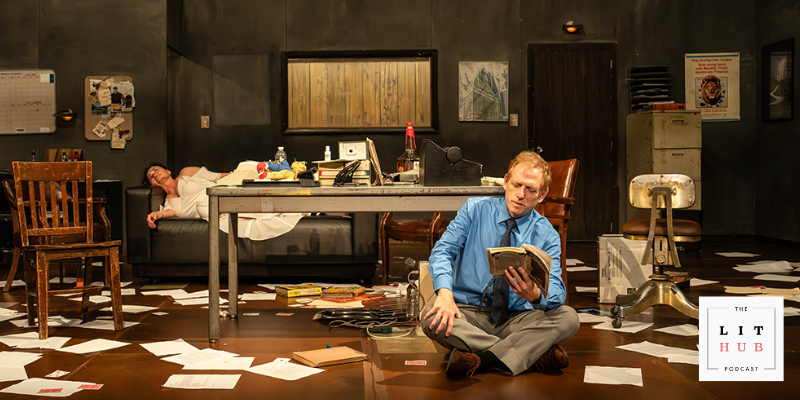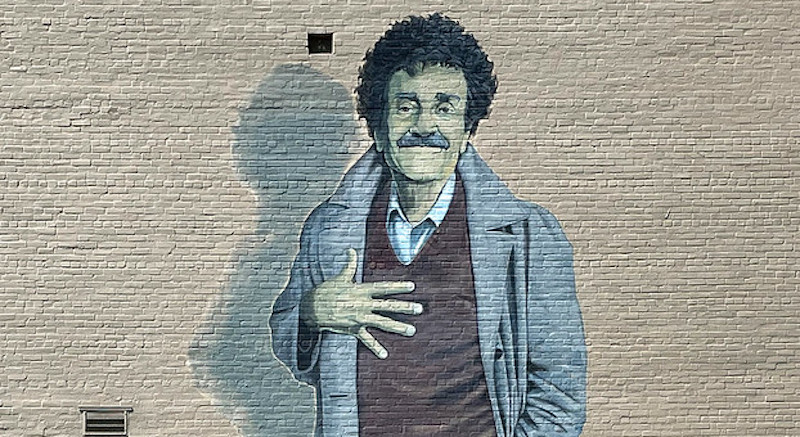There is an old joke about a confession. “Father, I must confess that I’ve sinned,” a man tells the priest, “I’m guilty of stealing.”
The priest asks, “What did you steal?”
“Well, a ham,” says the man.
“What did you do with it?”
Confusedly, the man responds, “I hid it under the bridge outside town.”
“Well, just leave it there and say three Our Fathers for your penance.”
He left the ham and said three Our Fathers for his penance. But he wondered why the ham should go to waste. The man went back to the bridge but found that the ham was stolen. The priest took it. The next time the man sinned, he went to confession, but with reservations. “Father, I must confess that I’ve sinned. I’m guilty of adultery.” The priest asks, “Who did you sin with?” Remembering the ham, he refused to tell.
This joke, rumored to be told by Polish immigrants in the Midwest, begins from a position of vulnerability, honesty, and submission to the big other (the priest)—the man has committed a small crime of dietary theft, but is forthcoming with the information and shows his willingness to repent for his nutritional indulgences. But as it happens, it is not solely the sinning man, a representation of the toiling masses, who betrays his confession, but also the priest, who, representing God and all that is otherworldly, commits a graver crime of nutritional betrayal. He forsakes both man and God for the ham.
I like to imagine the joke as a metaphor, maybe even a justification, for something more detached from the specificity of the joke and its fetishization of smoked hog: gatekeeping. Specifically the gatekeeping of one’s local spots from tourists or untrusted acquaintances. How hard it is to visit a new city and find the caliber of places it’s taken you years to find in your own city. And how wonderful it is when you just so happen to stumble across the perfect park or bookstore in a new city.
When the Columbus-born writer James Thurber went to Paris, he did not search for sites through the obvious means—tourist maps, advice from locals, advice from tourists who took advice from locals—but instead, the locations inside his favorite novel (Henry James’ The Ambassadors). When I visited the Midwestern city of Indianapolis, I relied not on the more obvious means of Top 10 Lists online, advice from locals, or Top 10 Lists online based on the advice from locals, but instead, on the online blackhole of Reddit. Despite what some might say of the website, it is the perfect location for must-see destinations in Indianapolis. One of these Indianapolis spots, or cherished hams, is a more obvious establishment, the Kurt Vonnegut Museum.
The Kurt Vonnegut Museum and library are housed in a modest three story structure on a corner past the city’s canals. It boasts items like Vonnegut’s typewriter, original drawings, and a complete selection of his re-published novels for purchase. I didn’t purchase any of his works, although I did like the cover of Fates Worse Than Death, which displays a portrait of Vonnegut standing in a field as if it were for his senior pictures. I did, however, buy a beanie with the museum logo and no price tag. It cost $30, a steep price for a head sock (but not so steep that I canceled the transaction).
Indianapolis, a city with its interior location and small population (under 900,000), has an unassuming reputation. The city is landlocked. Their squirrels are fearless, their street dwellers are numerous, and their reputation is hopelessly plain. It is a place where residents will walk by a dying butterfly—dead to the world and really dead—on the sidewalk without a second glance, a city where the population finds little inspiration in their professional football team called the Colts—which sounds indistinguishable from the Cults, a far more interesting team name. But Indianapolis has also housed two of America’s most read authors—Vonnegut and the YA author and vlogger, Hank Green, who moved to the city in 2007. Many flock to visit the city because they believe it is the resting place for Kurt Vonnegut.
When I traveled to Dayton, Ohio over the summer, I made a pilgrimage to the grave of the famous poet, Paul Laurence Dunbar, which happens to be next to the famous kings of aviation, the Wright Brothers. An excerpt of one of his Dunbar’s poems goes: “So long as the streams run down, / And as long as the robins trill, / Let us taunt old Care with a merry air, / And sing in the face of ill.”
When I visited Paris in the winter, I sat uncomfortably behind a flight of stairs where Richard Wright’s ashes are snugly kept in the corner next to a Gerard Renier. I left a terribly sketched portrait of him to show that at least some Americans put in the work to find his grave (he’s not listed on any of the silly tourist maps). It is common to visit the graves of figures in cities one visits and it is even common to visit one’s local cemetery as some do at the Greenlawn Cemetery to pay respects to the beloved James Thurber and his dog, Muggs. But to visit Vonnegut’s grave in Indianapolis is far harder than it is to visit Thurber’s in Columbus for one simple reason: he’s not there.
If you visit the Crown Hill Cemetery on the northside of Indianapolis, you will find the name Kurt Vonnegut on a gravestone and packs of Pall Mall cigarettes placed around it—Vonnegut’s only addiction, a nonlethal one as it turns out (he died by falling down the stairs). But the occupant resting underground is not the author. The tenant is an architect, his father, Kurt Vonnegut Sr., who designed some of the city’s most admirable structures like the 1907 Central Union Telephone Company building, which was, at risk of being demolished, instead picked up and rotated 90 degrees. It was later demolished in 1963. Vonnegut Sr. might disapprove of the cigarettes placed on his grave as he died from emphysema. Vonnegut Jr.’s remains are rumored to be in a crematory state, scattered elsewhere, perhaps in the wind.
There is a hum that permeates Indianapolis, a pulsing sound that is not quite industrial, but technological or mystic.
His being from Indianapolis is a common theme throughout Vonnegut’s novels and interviews. The first time I read Vonnegut was in his introduction to Anne Sexton’s twisted fable collection called Transformations. “Indianapolis,” he wrote in one of the first paragraphs, “is the world’s largest city not on a navigable waterway.” As an apologist for the Midwest myself, I respect a man who can, in the introduction to a fable collection of all places, find space to sell the reader on Indianapolis.
Vonnegut’s novels constantly talk about the Midwest—in the first three pages of Slaughterhouse-Five, he mentions Dayton, Ohio and Wisconsin—and there is rarely a piece written by him that doesn’t touch on the city of his origin. This is what he had to say about the Great Lakes region:
I am one of America’s Great Lakes people, her freshwater people, not an oceanic but a continental people. Whenever I swim in an ocean, I feel as though I am swimming in chicken soup.
And I must confess that I’ve been sold on the city of Indianapolis and their fresh water. Despite its unimpressive reputation and fearless squirrels, there are many admirable qualities to Indianapolis. It is a city with a bus rapid transit line that puts it a decade ahead of Columbus. It’s a city that boasts a number of bookstores (though none were open during my visit). There are also canals that put the city on a footing with London’s borough of Hackney. And of course, Indianapolis has a thriving immigrant population, including a strong Turkish community as represented by the famous Bosphorus Cafe located inside what looks like a repurposed 19th century home. “Indianapolis,” as my girlfriend put it, “is my Paris.” (She also told me, “I’ve been to every state except some.”)
In Slaughterhouse-Five, the main character, Billy Pilgrim, becomes unstuck in time. Vonnegut describes his first experience like so:
His attention began to swing grandly through the full arc of his life, passing into death, which was violet light. There wasn’t anybody else there, or any thing. There was just violet light and a hum.
We first noticed a pulsing hum in our Airbnb. After turning off the AC, we realized the hum was not from any one source, but from a general core, the core of the city. There is a hum that permeates Indianapolis, a pulsing sound that is not quite industrial, but technological or mystic. It continued through the night and followed us outside. We became adapted to the core and feared what kind of effect long-term exposure would have on our minds. The hum was real, or so we think, but there was something about the ominous noise that was otherworldly and distinctly Vonnegut-esque. It’s as though he, surpassing the confinement of fiction, funded a project to make the city itself unstuck in time.
Vonnegut’s imprint on the city is witnessed not just through the hum, but in the many businesses that reference his novels. The restaurant Bluebeard, named after his 1987 novel of the same name, restaurants like Milktooth offer Vonnegut-inspired cocktails like Player Piano, a drink mixed with brown sugar cranberry caramel, and cafes like Bovaconti Coffee boast a logo that seems to be inspired by the iconic Vonnegut illustration in Breakfast of Champions of a modestly lined butthole.
The two most important voices produced by Indiana, both of whom identified as socialists and produced a high output of written work, are the great Socialist presidential candidate, Victor Eugene Debs, and our beloved writer, Kurt Vonnegut. The notoriety of the former is echoed by Vonnegut who, at one point, inspired by Debs, wanted to become a labor organizer himself.
Like Twain before him, Vonnegut became more explicitly politicized in his later years. Twain’s most polemic work is not a humor piece, but an anti-war story called The War Prayer. A fictional prayer to protect the troops is interrupted by an angel who translates their coded prayer with an honest depiction about the reality of wishing brutal death on young men. He was afraid to publish it while alive, claiming that “I have told the whole truth in that, and only dead men can tell the truth in this world. It can be published after I am dead.”
Vonnegut, too, was hesitant to release his book of very political writings in his final years. His book A Man Without A Country, a collection of articles written for the Chicago-based left-wing magazine In These Times, calls attention to other Midwestern progressives like Carl Sandburg, Eugene Debs, and Abraham Lincoln. “Like me, many American socialists were freshwater people,” he wrote.
Just as Thurber had to leave his Midwestern city to write about it, so too did Vonnegut. Despite his long tenure in New York City, Vonnegut never abandoned the core Indianapolis. In a letter to the former head of Visit Indy, which is on display at the Kurt Vonnegut Museum, Vonnegut wrote: “Although I live in the East, I remain an aggressively and sometimes abrasively Indianapolis person, and remain such until I die.”


























































